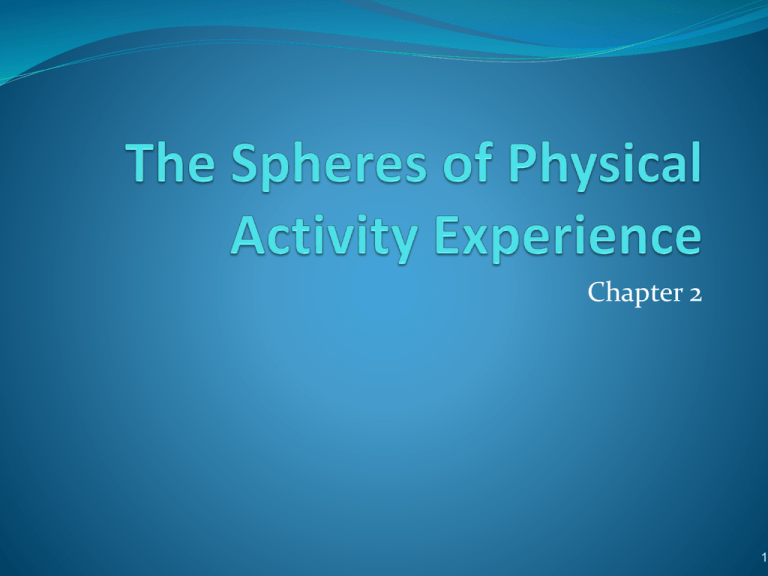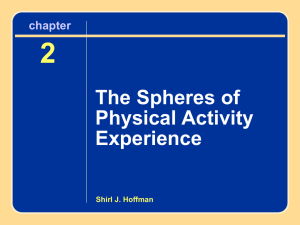
Chapter 2
1
The Importance of Physical Activity
Experience
How often and in what ways does physical activity occur
in your life?
Spheres of Physical Activity
Experience
Figure 2.1
The Spheres of Physical Activity
Experience
Do not classify types of physical activities
Highlight aspects of our lives in which
physical activity plays an important part
Show us that some activities may be
common to more than one sphere
Provide a general framework for thinking
about the importance and pervasiveness of
physical activity
Are not intended to compartmentalize
physical activity
Self-Sufficiency Sphere of
Physical Activity Experience
Figure 2.2
Sphere of Self-Sufficiency
ADLs: Activities of daily living
Personal behaviors
IADLs: Instrumental activities of daily living
Cooking, laundry, shopping
Home maintenance activities:
More complicated and demand more energy
than ADLs and IADLs
Self-Sufficiency and Aging
Physical Activity Limitations
By 2030, 22% of the U.S. population will be
65 or older.
11.8% of 55- to 64-year-olds have ADL
impairments.
Almost 50% of 85+ population have ADL
impairments.
Older people are often injured trying to do
ADLs and IADLs.
Quality of life is diminished.
Self-Sufficiency and Aging
Mobility (walking)
Nearly 20% of people 65 and older have
difficulty walking.
More than 50% of women and 33% of men
over age 85 have difficulty walking up 10 steps.
(continued)
Self-Sufficiency and Aging (continued)
Driving: Older Drivers . . .
Are fastest-growing segment of population of
drivers.
Do not have a disproportionately higher number
of car accidents.
Do have more accidents per mile driven.
(Austinhomecareassistance.com)
The Challenge for
Kinesiologists
Taking care of our own wants and needs and living
an independent life require, at the very least, the
ability to perform ADLs and IADLs.
Kinesiology can provide the knowledge and
professional expertise to help individuals maintain
an independent lifestyle.
Self-Expression Sphere of
Physical Activity Experience
Figure 2.4
Sphere of Self-Expression
Gestures
Emblems communicate.
Illustrators complement words.
Regulators guide conversation.
There are cultural differences in gestures.
Dance and rituals
Instrumental movements are required for
attaining goal.
Expressive movements are idiosyncratic.
Rituals express experience, truth, or values.
(continued)
Work Sphere of Physical Activity
Experience
Figure 2.6
What Kinds of Physical Activity Are
Required to Complete Your Job?
Think carefully about all the jobs you have had.
Compare the types of physical activities you were
required to complete in each job.
Be sure to think broadly about physical activity;
many “desk jobs” require physical activity such as
typing and filing.
Rate your jobs. Which were most strenuous?
How might your health have benefited from the
additional activity?
*Anyone know anyone who has NOT been able to do
job?
Sphere of Work
Physical activity is an integral part of our
work.
Physical activity produces goods and
services.
Specialists focus on improved efficiency,
greater productivity, and improved safety
in the work setting.
1.
2.
Ergonomists (where do we hear this term?)
Human factors engineers
Sphere of Work
Importance of physical activity in work
Ergonomists
Human factors engineers
Increases in sedentary types of work—risks of
reduced activity
Physical activity, efficiency, and injury in the
workplace
Physical and psychological demands of work
Human Factors Engineers Redesign
Equipment to Increase Efficiency and
Prevent Injuries
Figure 2.7
Reprinted, with permission, from Human Factors. Copyright 1989 by the Human
Factors and Ergonomics Society. All rights reserved.
The Challenge for
Kinesiologists
Physical activity is essential to work.
Physical activity professionals contribute to work
performance by improving the methods used to
perform work, redesigning inefficient
workspaces, and rehabilitating work-related
injuries.
Education Sphere of Physical
Activity Experience
Figure 2.8
Sphere of Education
Physical activity in all phases of education
Some examples…….
Our interest in sport, exercise and recreation
just tip of the iceberg
www.ice.ec.gc.ca
Sphere of Education
Instruction in sport and exercise
At one time limited to:
Public schools
College physical education
Recreation programs
Military
Today:
Sport & fitness centers
Corporations
Hospitals
Tennis, golf, swim clubs
Other?
Sphere of Education
Instruction in sport, fitness, and
exercise most visible and accessible in
physical education classes in school
curriculum
Physical education
Curriculum that teaches children
how to perform sport and exercise
Sphere of Education
Fitness
Health-related
Whether an objective that is emphasized in public
schools varies according to pressure exerted by society
What current issue might give support to emphasizing
health related activity in physical education classes?
Motor ability
Run, jump, skip – locomotion
Catch, throw, kick, strike – object control
Growing Problem of Overweight
Children and Adolescents
Figure 2.9
Data from USDHHS 2000.
Sphere of Education
Sport skill development
Develop responsible personal & social behavior
Provide opportunities for enjoyment, challenge, and self
expression
Attain/maintain physical fitness
Develop lifetime sport skills
Tennis, swim, golf, in-line skate
In order to develop these sport skills, physical
education classes must be scheduled on a daily basis so
teachers may develop skill competencies in their
students.
Objectives of Public School
Physical Education
Varying views: What is yours?
NASPE content standards: Objectives of physical
education (page 49 of textbook)
Physical fitness
Social responsibility
Objectives of Physical Education
A physically educated person
1. demonstrates competency in many movement
forms and proficiency in a few movement forms;
2. applies movement concepts and principles to the
learning and development of motor skills;
3. exhibits a physically active lifestyle;
4. achieves and maintains a health-enhancing level
of physical fitness;
(continued)
Objectives of Physical
Education (continued)
5. demonstrates responsible personal and social
behavior in physical activity settings;
6. demonstrates an understanding of and respect
for differences among people in physical activity
settings; and
7. understands that physical activity provides
opportunities for enjoyment, challenge, selfexpression, and social interaction.
The Challenge for
Kinesiologists
Education is critical to civilization. Public
school physical education is the one
physical activity experience shared by most
people, and when carefully planned by
kinesiologists it can benefit the student in
many ways.
Leisure Sphere of Physical
Activity Experience
Figure 2.10
Sphere of Leisure
Free time: Personal time not encumbered with
obligations
Leisure: State of being in which humans find deep
satisfaction and contentment
(continued)
Sphere of Leisure
Leisure pursuits encompass sedentary activities
such as:
Chess or reading
Physical activity as leisure activity:
Water skiing or softball
Focus of study of leisure as a discipline
Leisure studies or recreation
Kinesiology – large muscle form leisure pursuit
Sphere of Leisure
Activities such as golf, folk dancing, softball,
hiking, long runs in the park good potential for
leisure.
But – potential for leisurely disposition difficult.
How?
True leisure pursuit depends on:
Nature of the pursuit
Context in which it is pursued
Participant motivation and attitudes
Sphere of Leisure
Sports watching
Clearly on the rise
Over 180 million spectators attended professional
& college baseball, basketball, football, and pro
hockey games in 2000 up from 150 million in 1985
Tripled attendance for women’s college basket ball
since 1985
Sphere of Leisure
Concerns for physical activity professionals
Why?
Dilemma:
Jobs of physical activity professional
Coaches, athletes, athletic trainers
Sport management as a career gaining popularity
Sphere of Leisure
Aging and leisure physical activity
Due to health advances and study of aging,
individuals over 65 have great potential to learn
new skills and engage in physical activity.
Aging individuals realizing the benefits of
regular participation in leisure time activities.
Percentage of adults aged 18 years and over who engaged in
regular leisure-time physical activity: United States, 1997-2003
Figure 2.11
USDHHS, CDC, Summary Health Statistics for U.S. Adults: National Health Interview, 2001,
Series 10, 218. Jan. 2004, pg. 3
The Challenge for
Kinesiologists
Leisure, a state of being vital to humans, often
involves large-muscle physical activities. The
challenge for physical activity professionals is to
teach people to participate in free-time physical
activity pursuits in ways that nourish the
disposition known as leisure.
Health Sphere of Physical
Activity Experience
Figure 2.12
Sphere of Health
There is a strong relationship between physical
activity and health.
Physical activity and the national interest
Excessive health care costs
Death and disease associated with low physical
activity levels
Disease prevention and therapy through physical
activity
The Great Disconnect
Overweight U.S. Children and Adolescents
Reprinted, by permission, from C.L. Ogden et al., 2002, “Prevalence and trends in
overweight among US children and adolescents 1999-2000.” Journal of the American
Medical Association 288(14): 1728-1732. Copyright © 2000. American Medical
Association. All rights reserved.
Sphere of Health (continued)
Psychological effects of exercise
Increase secretion of mood altering hormones
Adjust level of psychological arousal
Reduce stress
Exercise and mental/emotional illnesses
Potential detriments of physical activity
Stress fractures from repetitive motions, muscle
strain
Unhealthy emotional dependence on exercise
Interferes with work or personal relationships
The Challenge for
Kinesiologists
Failure to make physical activity part of our
daily lives has led to a health crisis of
critical proportions.
Exercise professionals can provide the
safest, most effective, most efficient routes
to attaining health benefits from physical
activity.
Competition Sphere of Physical
Activity Experience
Figure 2.13
Sphere of Competition
Competition occurs in our daily lives.
Competition in physical activity is usually
associated with sport, although it can exist in
exercise.
Competition can be positive or negative.
Types of competition
Side by side
Face to face non contact
Face to face contact
Impersonal
Figure 2.14a and 2.14b
(continued)
Figure 2.14c and 2.14d (continued)
50
The Challenge for Kinesiologists
Competition comes naturally to humans, and
physical activity is an important avenue for
expressing our competitive natures.
Competition can express itself in a positive or
negative manner.
Kinesiologists need to teach sport skills and create
environments in which enjoyable competition can
take place.
Fair play
Similar performance levels
Reduce injuries
Table 2.1
52
Physical Activity Experience:
Words to live by!
Your life is filled with physical activity experiences.
Think carefully about how these experiences
contribute to your independence; your ability to
perform necessary personal, social, and workrelated tasks; and your enjoyment of life.







